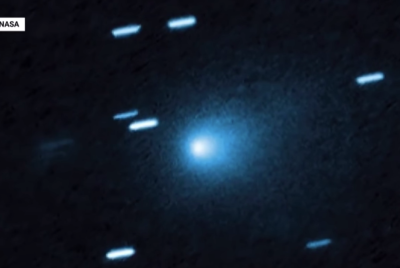That's Not 3I/ATLAS: New 'Nearly Interstellar' Comet to Fly By

The solar system is meant to be a familiar place, a cosmic neighbourhood defined by predictable, elliptical paths. Yet, every few years, an intruder arrives—a celestial visitor from the dark expanse between the stars, sending astronomers and the public into a flurry of excitement.
This year, the focus has been intensely fixed on 3I/ATLAS, only the third confirmed interstellar object known to have passed through our star system. It is a true alien from beyond our stellar shores, whose movements have been closely tracked by global observatories.
But as with all cosmic drama, a twist has emerged. While the world tracks the progress of the true interstellar visitor, another comet has been making its own dramatic flyby, leading to widespread and incorrect speculation that 3I/ATLAS was making a surprise appearance after being hidden temporarily from observers.
This new object, Comet C/2025 V1 (Borisov), is the actual 'nearly interstellar' wanderer currently captivating observers. It is due to reach its closest point to Earth today, Tuesday, November 11, reminding us that our solar system is not quite as tidy as we might think.
Unmasking the Near-Interstellar Comet C/2025 V1 (Borisov)
The object that has stolen the spotlight is officially named Comet C/2025 V1 (Borisov). While it shares a high orbital eccentricity with its interstellar cousins, meaning its path is highly non-periodic and nearly hyperbolic, it is distinct from 3I/ATLAS.
It is believed to originate from the Oort Cloud, the vast, icy sphere of debris surrounding our solar system, making it an extremely distant, but ultimately local, traveller. This distinction is crucial, yet the public confusion has been significant enough for astronomers to clarify the separate identities of these two cosmic snowballs.
Comet C/2025 V1 (Borisov) is making an extremely close pass to our planet by astronomical standards. It will hurtle past at a distance of approximately 103,119,940 kilometres, or 0.68 AU (Astronomical Units). This flyby occurs just before the comet reaches its perihelion—its closest approach to the Sun—which is scheduled for November 16. Unfortunately, its visibility is challenging.
With a peak brightness of 14.6 magnitude, it is far too faint to be observed with the naked eye. In fact, stargazers will need an exceptionally large telescope, likely with an aperture of at least 20 inches, to sight it as it travels through the constellation of Virgo in the western sky. Its high orbital eccentricity, measured at $e=1.00958273$, is what gives it the 'nearly interstellar' moniker, placing it just outside the standard range of comets bound to the Sun.
The True Interstellar Visitor: Tracking Comet 3I/ATLAS
To truly understand the mix-up, one must look at 3I/ATLAS, the original object of astronomical fascination. Its 'I' designation confirms its status as an interstellar object, one that has traversed the void between star systems to visit our own.
Discovered in July 2025 by the Asteroid Terrestrial-impact Last Alert System (ATLAS), this comet is believed to have formed in another star system billions of years ago. Observations have revealed it to be a massive object, potentially measuring up to 10 kilometres in diameter, raising questions about how such a large interstellar body could exist without smaller ones being detected first.
Unlike Comet C/2025 V1 (Borisov), the actual 3I/ATLAS passed its closest point to the Sun, or perihelion, on 30 October 2025. It made its closest approach to Earth much later, on 19 December 2025, at a comparatively safer distance of 270 million kilometres (1.8 AU).
Astronomers have been using the Hubble Space Telescope and the James Webb Space Telescope to study its composition, detecting carbon dioxide, water, and even an unexpectedly high abundance of nickel. Furthermore, the comet has exhibited strange behaviours, including anti-tail jets pointing towards the sun, which Harvard astrophysicist Avi Loeb has controversially suggested could be a 'Trojan horse' or artificial technology. This kind of unusual activity is what makes 3I/ATLAS so compelling to planetary scientists.
Ultimately, the brief confusion between these two objects highlights the unpredictability of space. As Comet C/2025 V1 (Borisov) completes its fleeting passage and returns to the Oort Cloud, and 3I/ATLAS continues its journey out of our star system, both serve as powerful reminders of the dynamic, ever-changing environment just beyond our planetary neighbourhood.
The movement and composition of Comet 3I/ATLAS has continued to baffle astronomers, making it even stranger. 3I/ATLAS Just Got Stranger.
© Copyright IBTimes 2025. All rights reserved.





















